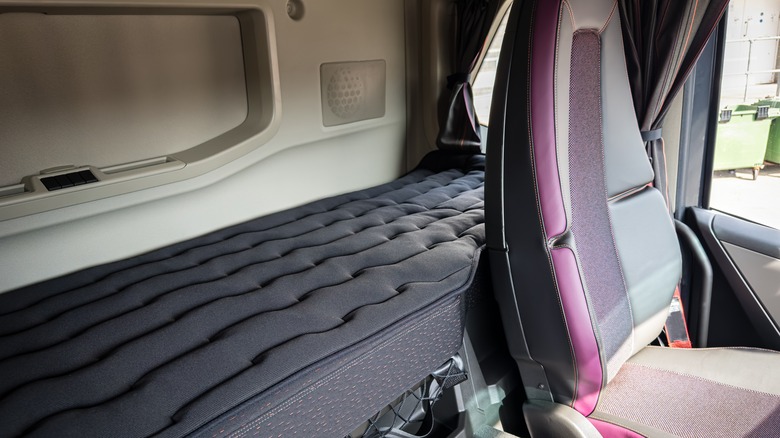What Is The Small Window On The Top Of A Semi-Truck Cab For?
Passing a semi-truck on the highway, your eyes might be more drawn to the trailer on the back than the cab pulling it — especially if its plastered with pictures of snack cakes or images of fast food. But have you ever noticed one of those small windows near the top of some semi-truck cabs? Turns out, those aren't just some decorative thing: It actually means that the semi-truck contains a sleeper cab.
Semis with sleeper cabs have a built-in sleeping compartment where truckers can spend their mandated off-duty hours. That little window gives light and ventilation for the bunk area, typically found directly above or right behind the driver's seat. With more than 3.5 million professional truck drivers in the United States, sleeper cabs are both a convenience and a requirement for those who don't have the time, space, or means to sleep somewhere else after a long day (or night) on the road.
Sleeper cabs are there to give drivers a rest
The Federal Motor Carrier Safety Administration (FMCSA) mandates that long-haul drivers take at least a 10-hour break after reaching the maximum 11-hour driving limit. Per those rules, that downtime must be spent either off-duty or in a sleeper cab. With limited parking options on the road and strict delivery deadlines to meet, the sleeper cab is a very convenient way to check the FMCSA's boxes and get some rest without actually having to leave the truck.
When sleeper cabs were first introduced nearly a century ago, it changed modern trucking. These mandatory rest periods are there to cut down on driver fatigue and reduce the risk of any drowsy driving crashes. Without a proper sleeping space, drivers would otherwise be forced to sleep in motels, at rest stops, or in a roadside parking spot at the end of a long shift. With these cabs, they have a way to immediately get some sleep without having to worry about finding another bed elsewhere.
Sleeper cabs have to follow certain regulations
To be officially recognized as a sleeper cab, the compartment must meet the design standards outlined by the FMCSR. Those standards will vary depending on when the cab was installed, but the fact remains: The cab has to meet the minimum dimension and installation guidelines in order to be compliant. The cabs also have to be properly ventilated to protect the driver from exhaust heat, fumes, and fuel leaks — hence the small window on the top of the cab (not to be confused with the little window at the bottom of the truck for visibility).
To comply with FMCSA's rules, drivers can take their 10-hour break entirely inside of a semi-truck sleeper cab, outside the truck, or a combination of the two. While these regulations are there to ensure basic safety, some modern sleeper cabs go far beyond the minimum. Some semi-trucks have comfy mattresses, power outlets, microwaves, refrigerators, and even small dining areas and infotainment systems — just like a little studio apartment.


